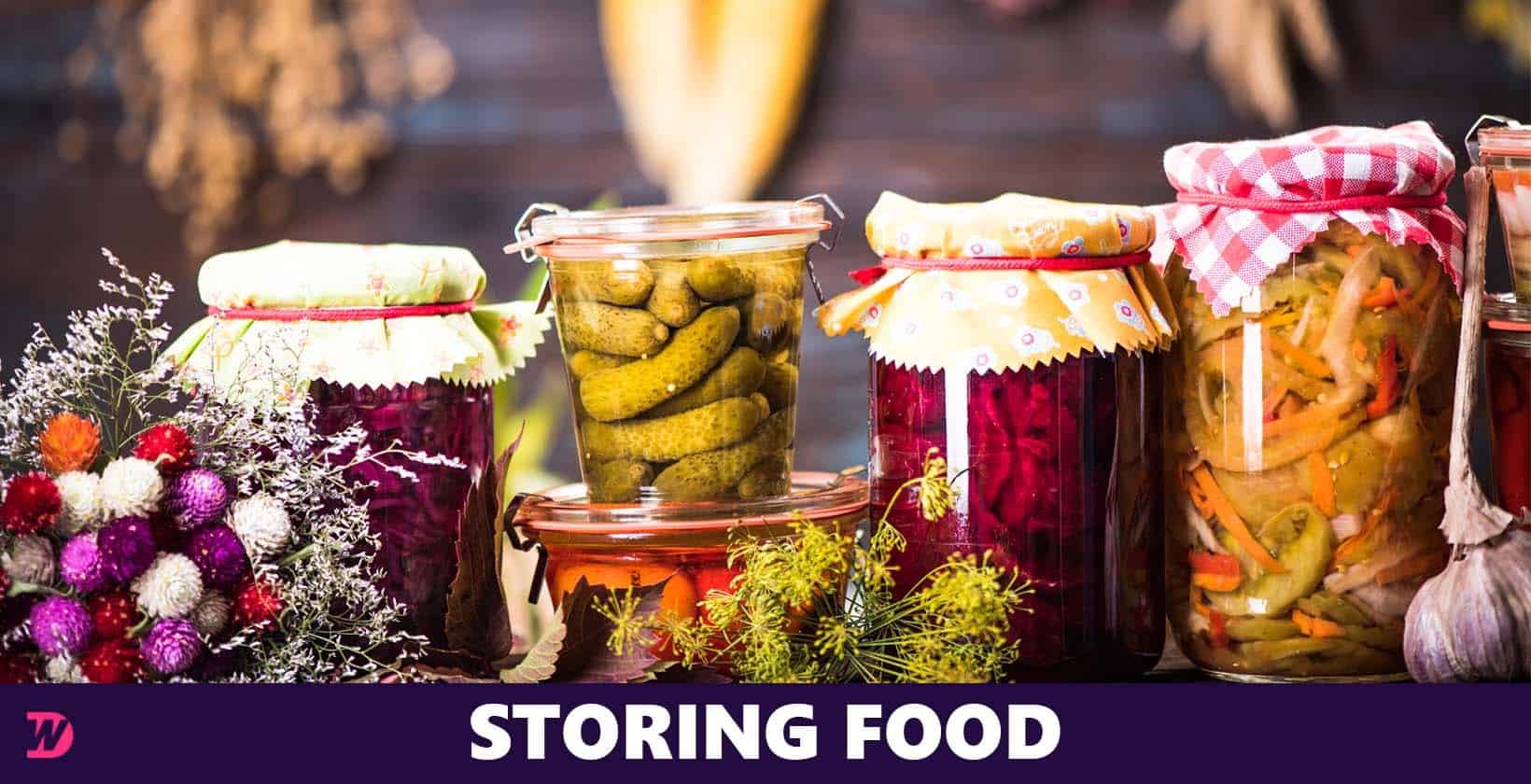Storing food safely prevents foodborne illnesses and helps in slowing or preventing the growth of harmful microorganisms like Salmonella, E. coli O157:H7, and Clostridium botulinum, the latter of which causes botulism. Whether you’re putting food in the refrigerator, freezer, or cupboard, following proper food storage guidelines can significantly reduce your risk of being sickened by these dangerous bacteria.
According to the Centers for Disease Control and Prevention (CDC), foodborne illnesses cause around 48 million illnesses, 128,000 hospitalizations, and 3,000 deaths in the United States each year. With these alarming statistics, it’s clear that taking food storage seriously can have a significant impact on public health. To keep food from spoiling and prevent the growth of harmful bacteria, it’s important to store food at the proper temperature. The USDA Food Safety and Inspection Service recommends keeping the refrigerator temperature at or below 40°F (4°C) and the freezer temperature at 0°F (-18°C) to ensure the safety of perishable foods.
VIEW IN GALLERY
In addition to temperature control, proper storage practices also involve using airtight containers and packaging, keeping raw and cooked foods separate, and rotating food so that the oldest items are used first. These practices, along with regularly cleaning and sanitizing your food storage areas, can help you keep your food safe and free of harmful bacteria.
The Three Types of Food
Understanding the difference between perishable, semi-perishable, and staple foods can help you keep your food fresh and safe to eat for longer.
1. Perishable Foods
Perishable foods are those that have a limited shelf life and are susceptible to spoilage due to bacteria, mold, and yeast. These foods need to be refrigerated or frozen and consumed within a certain time frame to prevent foodborne illnesses. Examples of perishable foods include meats, dairy products, eggs, and fresh fruits and vegetables.
2. Semi-perishable Foods
Semi-perishable foods are those that can last for a longer period of time than perishable foods but still need proper storage to prevent spoilage. These foods can typically be stored in a pantry or cupboard, but should still be consumed within a reasonable timeframe. Examples of semi-perishable foods include bread, crackers, and some canned goods.
3. Staple, or Non-perishable Foods
Staple, or non-perishable foods, are those that can be stored for extended periods of time without refrigeration or freezing. These foods are typically packaged or processed in a way that makes them shelf-stable, and they can be stored in a pantry or cupboard without the risk of spoilage. Examples of staple foods include dried pasta, rice, and some canned goods such as beans or fruits.
Food Storage Basics
Proper food storage is crucial for maintaining food safety. This includes refrigerating or freezing perishables right away, keeping appliance temperatures at the appropriate levels, following storage instructions on food labels, consuming ready-to-eat food promptly, being aware of spoiled food, and understanding the risk of foodborne illness.
- Store perishable items as soon as possible: When you get home, make sure to put all items that require refrigeration in the fridge right away. Try to avoid leaving perishable items at room temperature for more than two hours, and reduce this time to one hour if the temperature is above 90°F. This includes leftovers, take-out food, and “doggie bags.” Make sure your refrigerator or freezer is not overly packed, allowing air to circulate properly.
- Proper appliance temperatures: Keep the temperature in your refrigerator below 40°F (4°C) and your freezer at 0°F (-18°C). Use an appliance thermometer to check the temperatures regularly.
- Label instructions: More than just meat, vegetables, and dairy products need to be kept cold. Always check the storage instructions on food labels and dispose of any items that have not been properly refrigerated.
- Use ready-to-eat food promptly: Try to consume refrigerated ready-to-eat foods, such as lunch meats, as soon as possible. The longer they’re stored in the refrigerator, the greater the risk of Listeria growth, especially if the temperature is above 40°F (4°C).
- Watch for spoilage: Discard any food that appears or smells suspicious, or has visible mold growth. Mold can grow even in the refrigerator and can make food unappetizing.
- Awareness of foodborne illnesses: Food can still cause foodborne illness even if it doesn’t look, smell, or taste spoiled. This is because it may be contaminated with pathogenic bacteria, which are different from spoilage bacteria. Raw or undercooked meat, poultry, seafood, milk, and eggs, unclean water, and fruits and vegetables can all harbor these pathogens. To reduce the risk of foodborne illness, make sure to properly refrigerate food, wash your hands and surfaces, separate raw and ready-to-eat food, and cook food to safe temperatures.
Ways to Store Food
With various food storage methods available, it’s important to understand the pros and cons of each method and to determine the best solution for your needs and your food. This research paper will explore the different ways of storing food, including canning, freezing, drying or dehydration, fermenting, pickling, and cold storage.
Canning food
Canning is a process of preserving food by sterilizing it and sealing it in an airtight container. This method of food storage has been used for centuries and is still popular today.
Pros: Canning provides a long shelf life for food, making it a convenient option for storing food for extended periods. It also allows you to preserve food at its peak freshness and prevent spoilage.
Cons: Canning can be time-consuming and requires specialized equipment, such as canning jars and lids, and a pressure canner. Additionally, the process of canning can affect the taste and texture of some foods, making it less appealing.
Freezing food
Freezing is a simple and effective way of preserving food by storing it at a temperature below 32°F (0°C). This method is widely used for preserving fruits, vegetables, meat, and other foods.
Pros: Freezing is a quick and easy way to preserve food, and it does not require specialized equipment. It also preserves food for an extended period and helps to reduce food waste.
Cons: Freezing can cause some foods, such as fruits and vegetables, to become soft and lose their texture, making them less appealing. Additionally, freezer burn can occur if food is not stored properly, which can affect the taste and quality of the food.
Drying or Dehydration Food
Dehydration is a process of removing water from food to preserve it. This method of food storage is often used for fruits, vegetables, and meats.
Pros: Dehydration reduces the weight and volume of food, making it convenient for storage and transportation. It also preserves food for an extended period, and the lack of moisture helps to prevent spoilage.
Cons: Dehydration can affect the taste and texture of food, and it requires specialized equipment, such as a dehydrator or an oven. Additionally, rehydrating some foods, such as fruits, can be difficult and time-consuming.
Fermenting Food
Fermentation is a process of preserving food by converting sugars and starches into lactic acid. This method is used for various foods, including vegetables, dairy products, and beverages.
Pros: Fermentation preserves food for an extended period, enhances the flavor and nutrition of food, and provides probiotics for a healthy gut.
Cons: Fermenting can be time-consuming and requires specific conditions, such as temperature and pH, to be maintained. Additionally, some people may have difficulty digesting fermented foods, and the process can also produce harmful bacteria if not done correctly.
Pickling Food
Pickling is the process of preserving food by immersing it in a mixture of vinegar, salt, and spices. Pickling has been used for centuries to preserve food and to add flavor. Some common foods that are pickled include cucumbers, beets, and eggs.
Pros: Pickling can add flavor to foods, making them more enjoyable to eat. It can also improve the nutritional value of food by adding vitamins and minerals. And it’s a relatively easy process that can be done at home.
Cons: Pickling can cause foods to lose some of their texture and flavor. Additionally, it can result in a high salt content in the final product, which can be harmful for those who need to restrict their salt intake. It can also result in a strong, sour flavor that some people may not like.
Cold Storage
Cold storage is a method of preserving food by storing it at low temperatures, usually below 40°F (4°C). Cold storage can be achieved by refrigerating or freezing food.
Pros: Cold storage can prevent the growth of harmful bacteria and pathogens, reducing the risk of foodborne illness.
Cons: Cold storage can be expensive, especially if you need a large amount of storage space. It can also be wasteful, as energy is needed to maintain the low temperature.



















